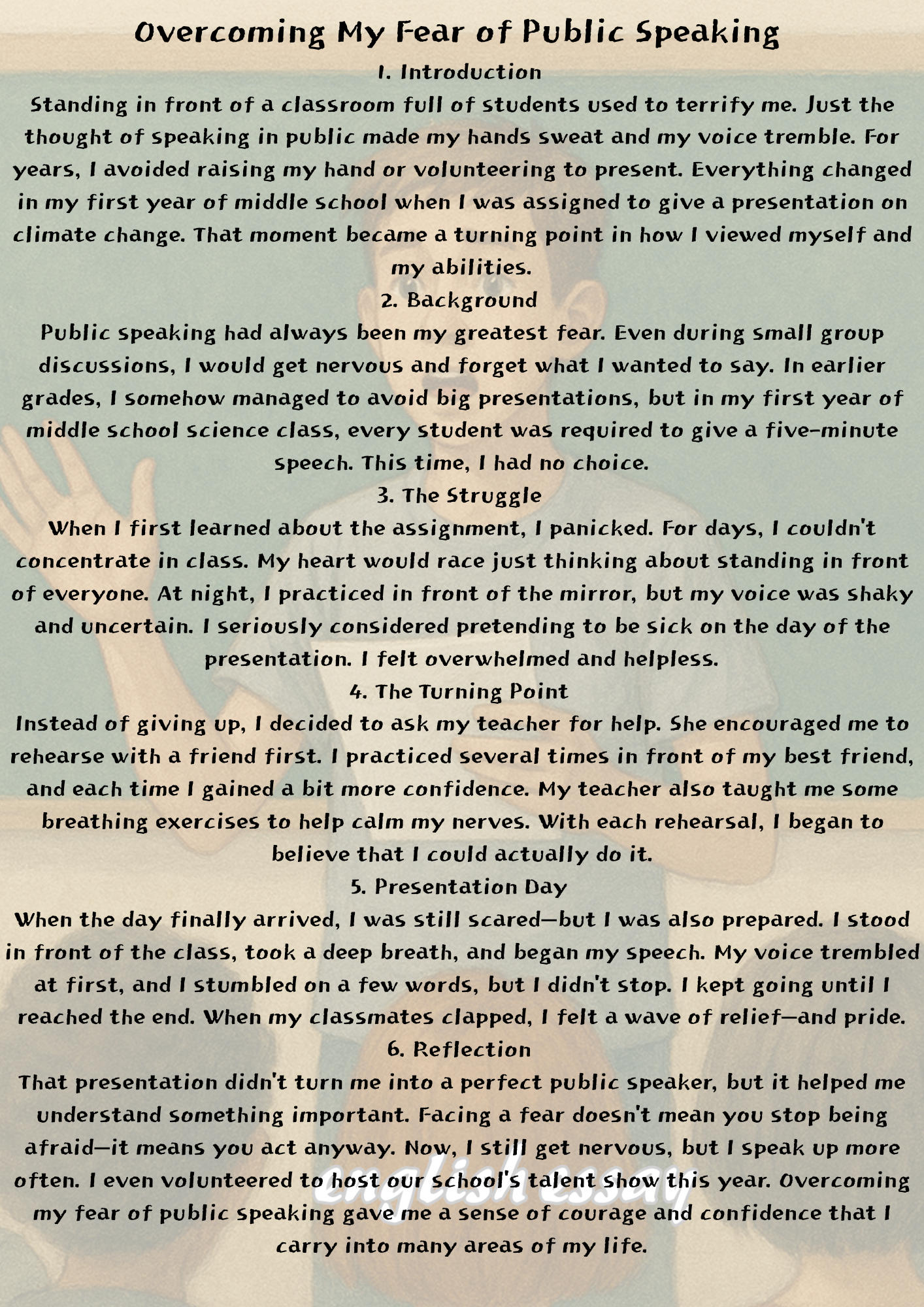티스토리 뷰
📝 How to Write an English Essay on “A Personal Challenge” | "개인적인 도전"에 대한 영어 에세이 쓰는 법
영어에세이 2025. 6. 15. 17:17개인적인 도전 경험을 주제로 한 영어 에세이 작성법을 소개합니다. 아이디어 발상부터 구조 설계, 표현 강화, 최종 수정까지 단계별로 안내하며, 중학생 이상 학습자에게 적합한 자기 성찰형 글쓰기 가이드입니다.

1. Understand the Prompt | 주제를 정확히 이해하기
What it means:
You are expected to describe a personal challenge you've faced and explain how you overcame it. This is not simply a story—it’s a reflective piece. You must share your thoughts, emotions, actions, and the lessons learned. The goal is to help the reader understand not only what happened but also how it helped shape your personal growth.
Keywords to notice:
"personal, " "challenge, " "overcame" – These keywords form the foundation of your essay. Your writing should clearly express all three.
무엇을 의미하나요?
개인적으로 겪은 도전적인 경험을 서술하고 그것을 어떻게 극복했는지를 설명하는 글입니다. 단순한 사건의 나열이 아닌, 그 경험을 통해 느낀 생각과 감정, 그리고 배운 점을 담아야 합니다. 독자가 당신의 성장을 느낄 수 있도록 써야 합니다.
중요 키워드:
'personal(개인적인)', 'challenge(도전)', 'overcame(극복한)' – 이 세 단어는 에세이의 핵심을 이루며, 글 전반에 명확하게 드러나야 합니다.
2. Brainstorming Ideas | 아이디어 떠올리기
Tips:
- Choose one specific, meaningful event.
- It can be physical (learning to ride a bike), emotional (overcoming fear), or social (adjusting to a new school).
- Ask yourself: What was the challenge? Why was it difficult? How did I feel? What did I do about it?
- Consider experiences from school, home, friendships, or hobbies.
- Reflect on a failure that turned into a valuable life lesson.
팁:
- 의미 있고 구체적인 경험 하나를 선택하세요.
- 신체적(예: 자전거 배우기), 감정적(예: 두려움 극복), 사회적(예: 새 학교 적응) 도전 모두 좋은 주제가 됩니다.
- “무엇이 도전이었나?”, “왜 힘들었나?”, “어떤 감정을 느꼈나?”, “무엇을 했는가?”를 스스로에게 물어보세요.
- 학교, 가정, 친구, 취미 등 일상 속에서 성장의 기회가 있었던 순간을 떠올리세요.
- 실패를 통해 교훈을 얻은 경험도 훌륭한 주제가 됩니다.
3. Structure Your Essay | 글의 구조 만들기
Recommended Structure (5 paragraphs):
- Introduction – Briefly introduce the challenge.
- Background – Provide context and explain why it mattered.
- Struggle – Describe what was hard and how you felt.
- Overcoming – Share what you did to solve or handle the problem.
- Reflection – Explain what you learned and how you grew.
추천 구성 (5문단):
- 도입 – 도전 경험을 간단히 소개합니다.
- 배경 – 그 일이 왜 발생했는지, 왜 중요한지 맥락을 설명합니다.
- 고난의 순간 – 어떤 점이 힘들었는지, 감정은 어땠는지를 묘사합니다.
- 극복 과정 – 문제를 해결하거나 적응한 과정을 서술합니다.
- 성찰 – 이 경험을 통해 어떤 점을 배웠고 어떻게 성장했는지를 마무리합니다.
4. Use Strong Sentences | 인상 깊은 문장 쓰기
Useful Expressions:
- "At first, I felt completely lost."
- "I realized I had to try a different approach."
- "Despite many setbacks, I didn’t give up."
- "This experience taught me resilience."
- "Looking back, I see how much I’ve changed."
유용한 표현:
- "처음에는 완전히 길을 잃은 기분이었어요."
- "다른 방식이 필요하다는 걸 깨달았어요."
- "여러 번 좌절했지만 포기하지 않았어요."
- "이 경험은 나에게 끈기를 가르쳐줬어요."
- "돌이켜보면, 나는 많이 달라졌다는 걸 느껴요."
These types of expressions add sincerity to your writing and help readers connect with your story.
이러한 표현들은 글의 진정성을 높이고 독자의 공감을 이끌어낼 수 있습니다.
5. Edit and Finalize | 퇴고와 마무리
Checklist:
- Did I stay focused on one challenge?
- Did I explain my feelings and actions clearly?
- Are the sentences vivid and structured?
- Does my conclusion reflect personal growth?
체크리스트:
- 하나의 도전에 집중했나요?
- 감정과 행동을 명확하게 설명했나요?
- 문장이 구체적이고 읽기 쉬운 가요?
- 결말에서 나의 성장이 드러나고 있나요?
Tip: Read your essay out loud. If it sounds natural, it likely flows well.
팁: 에세이를 소리 내어 읽어보세요. 자연스럽게 읽힌다면 좋은 글입니다.
관련글
👉학년별 영어 에세이 작성 팁📚 초등학생부터 고등학생, 성인까지 단계별 가이드


